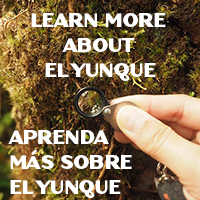Caribbean Dwarf Filter Shrimp

Caribbean Dwarf Filter Shrimp (Eng.), Camaroncito de Rio (Sp.), Micratya poeyi (Sci.). Native, Greater Antilles (Cuba, Jamaica, Puerto Rico)
Photo: © 2004 Chris Lukhaup. Information compiled by Alan Mowbray, USDA Forest Service, El Yunque National Forest.
General Information
Taxonomy: Class – Malacostraca;Order – Decapoda;Family – Atyidae; Genus – Micratya; Species – M. poeyi.One of ten riverine shrimp species that occur in Forest streams and pools – they are crustaceans of the order Decapoda (deca=ten; poda=foot) – they have five pairs of articulated legs.
Description
The Caribbean Dwarf Filter Shrimp is typically no larger than 1 inch (2.5 centimeters) in total length – color varies between black and white and reddish-white stripes.
Habits
M.poeyi are nocturnal animals, but can be found during daytime hours in forest pools and riffles. At night they congregate on submerged rocks, tree branches, roots and leaves. They are filter-feeders, taking-in tiny particles from the water column through specialized structures that resemble paint brushes, located on the first two pairs of legs (pereiopods). They feed mainly on microscopic algae and decomposing material. In this way they aid in organic material recycling and help to clean the surrounding water. Reproduction occurs during summer months. Mating occurs with the male at a right angle to the female, transferring a spermatophore to a specialized receptacle on the female’s abdomen. Six to twenty hours after mating, the female begins to produce a large quantity of eggs which she carries under her abdomen. After development, the eggs are released, and hatch into larvae, which are then moved down the river to estuaries and the sea. Larvae which cannot reach the sea within four or five days die-off. For 30 to 50 days, the larvae undergo a series of transformations in this saline environment. After that, they become post-larvae (tiny shrimp), approximately 0.5 inches long. During this post larval period they live and forage near the bottom. They soon start an upstream migration in search of freshwater pools where they will spend the remainder of their lives. M. poeyi becomes sexually mature within four to six months after reaching the juvenile stage.
Habitat
The Caribbean Dwarf Filter Shrimp occurs in most Forest waters – they can often be seen scurrying across the bottom of streams and pools near El Yunque’s nature trails.
Conservation
M. poeyi is listed as least-concernedby the International Union for the Conservation of Nature (IUCN).



